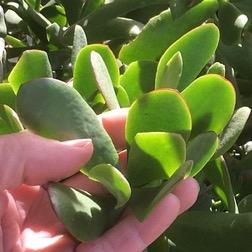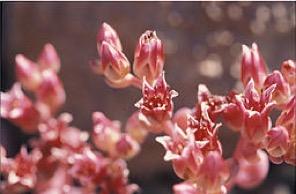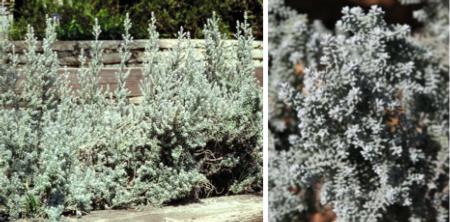GET CULTURED: Nitrogen and water use of winter- and summer-growing succulents
by Donald J. Merhaut
A new study, which has been funded by the California Association of Nurseries and Garden Centers (CANGC), is being conducted over a one-year period to determine nitrogen uptake patterns and water use of succulents from different native habitats.
Over the past several months our lab has been collecting plant material to represent “winter-growing” and “summer-growing” succulents that are usually commonly grown in the nursery trade. These terms are used loosely, given that our climate will cause some of these species to grow year-round or perform in different growth cycles than they would normally do in their native habitat. Our goal is to determine nitrogen and water needs throughout a one-year growth cycle, determining if there are differences between winter- and summer-growing succulents.
Plant Material and Their Origins
The majority of the plant species in our research study represent plants native to deserts, or seasonally dry tropical, subtropical or temperate climates. There are many factors that may influence the growth cycles and nutrient uptake patterns of these succulents. These factors include seasonal rain patterns, seasonal temperature fluctuations and day length patterns, as well as soil types.
Rainfall. Some climates have one wet and one dry season, such as California’s coastal climate. However, other regions experience two or more wet and dry cycles per year, such as the Amazon. The Eastern Cape of South Africa, where Crassula ovata (fig. 1) is native, has a fairly uniform distribution of rainfall over the year.

Daylength. Daylength is also quite variable, depending on proximity to the equator. Some species, such as Sansevieria trifasciata, are native to equatorial regions of West Africa where daylength is near 12 hours year-round, while other species such as Opuntia argentiniana (Argentina – Southern Hemisphere) and Sedum laxum ssp eastwoodiae (California – Northern Hemisphere, fig. 2)are native to latitudes 30° to 40°S and 40°N, respectively, where the shortest and longest days are 9 hours and 15 hours, respectively.

Temperature. Most succulents are from warm temperate to tropical climates. However, some succulent species are native to more alpine-like areas where a defined winter season does occur.
Soil Type. Soil type may not influence dormancy patterns, but nutrient uptake could be influenced. Most succulents are native to high mineral soils that are well drained. In this study we selected Maireana sedifolia, Australian Pearlbush (fig.3), which is native to the alkali flats of the Western Australia desert. Other species, such as Sansevieria, are native to soils with more sediment.

Succulents Studied in Our Research Project
Based on the review of the literature and the inventory of several succulent nurseries in southern California, we developed a list of 18 different plant species that provide a general representation of the different world climates from which our ornamental succulents are native: 9 winter-growing and 9 summer-growing succulents (table 1). Though we originally proposed to do only 5 winter- and 5 summer-growing succulents, it became obvious that the plant palette diversity had to be increased so that most succulent native habitats are represented in the study. This should give a better understanding of growth and nitrogen uptake patterns when these plants are grown in artificial conditions of a greenhouse. Based on the results, we hope to refine fertilizer and water management for succulent production. Please stay tuned to future issues of UCNFA News for further developments in this study.
|
Growing Season |
Succulent |
Family |
Habitat |
|
Winter (Summer Dormant) |
Aeonium haworthii
|
Crassulaceae |
Morocco (Africa) and Canary Islands |
|
Winter |
Crassula ovata |
Crassulaceae |
Eastern Cape Province of South Africa |
|
Winter |
Dudleya brittonii |
Crassulaceae |
Coastal Baja, Mexico |
|
Winter |
Haworthia attenuata |
Xanthorrhoeaceae |
Eastern Cape Province, South Africa |
|
Winter |
Maeriana sedifolia |
Chenopodiaceae |
Nullarbor Plain, Southern Australia |
|
Winter |
Portulacaria afra |
Didierearceae |
South Africa along rocky slopes (Kalahari Desert) |
|
Winter |
Sansevieria trifasciata hahnii |
Asparagaceae |
Nigeria to Republic of the Congo, Africa |
|
Winter |
Sedum laxum eastwoodiae |
Crassulaceae |
Northern California, Southern Oregon, USA |
|
Winter |
Sempervivum arachnoidium |
Crassulaceae |
Southern Europe
|
|
Summer (Winter Dormant) |
Agave victoriae-reginae |
Asparagaceae (formerly Agavaceae) |
Chihuahuan Desert, Mexico |
|
Summer |
Aloe juvenna |
Xanthorrhoeaceae |
Kenya, Africa |
|
Summer |
Euphorbia (Pedilanthus) antisyphilitica |
Euphorbiaceae |
Chihuahuan Desert |
|
Summer |
Euphorbia (Pedilanthus) tithymaloides |
Euphorbiaceae |
Chihuahuan Desert, Sonoran Desert, Caribbean and Virgin Islands |
|
Summer |
Kalanchoe tomentosa
|
Crassulaceae |
Madagascar
|
|
Summer |
Opuntia argentiniana
|
Cactaceae |
Argentina |
|
Summer |
Pachypodium lamerei
|
Apocyanaceae |
Madagascar |
|
Summer |
x Pachyveria scheideckeri |
Crassulaceae |
Metztitlan, Mexico
|
|
Summer |
Euphorbia milii
|
Euphorbiaceae |
Madagascar |
Table 1. Winter- and summer-growing succulents from different native habitats to be used in our study to determine nitrogen uptake patterns and water use.
Don Merhaut is a UC Cooperative Extension Specialist for Nursery and Floriculture Crops, Department of Botany and Plant Sciences, UC Riverside.












